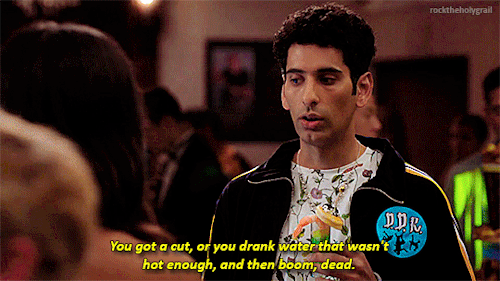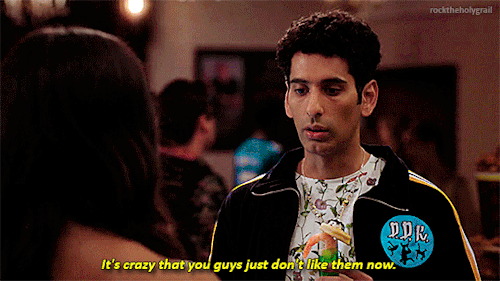We-are-all-paranoid - Microbe Nerd Alert





More Posts from We-are-all-paranoid and Others






The Good Place (2016-2020)

WATCH THIS VIDEO
a very, VERY important post. spread everywhere and screen record the video to your phone. or message me and ill happily send you the video. give to every woman and girl you know.
bc as they both said / demonstrated, its not only super easy to do, but super easy to miss.

candida and lactobacillus image under microscope / routine laboratory diaries
Reminder that the "fittest" in "survival of the fittest" does not mean "strongest/most violent".
It refers to an animal that is best fitted to thriving in a given ecological niche. A fit animal is one that is successful at the tasks of finding food food and water, avoiding predators, and reproducing, by whatever means work best for their situation.

google's search suggestion feature helps us to articulate a question that we've all been wondering about but have never been able to put into words: "Can bacteria make smarter?"





"Pelomyxa are giant amoeba, capable of growing as much as 5 millimeters in length. So it doesn't seem like they should be that difficult to find. In fact, Jame--our master of microscopes--found hundreds of them filling up his pond tank, completely visible without the help of a microscope. They were so large that he actually took one and touched it. So, if you would like to know what it feels like to pet an amoeba, he is now an expert. He says, "It's squishy.""
Journey to the Microcosmos- The Microbe That's Big Enough to Pet
Images Originally Captured by Jam's Germs
Quote Voiced by Hank Green

Mitochondria are primarily known as the powerhouse of the cell. However, these cellular organelles are required not only for providing energy: Professor Konstanze Winklhofer and her group at the Faculty of Medicine at Ruhr University Bochum, Germany, recently discovered that mitochondria play an important role in signal transduction in innate immune pathways.
They regulate a signaling pathway that helps to eliminate pathogens, but can cause damage through inflammation upon overactivation. The research team published their findings in the EMBO Journal.
Continue Reading.
Slime Molds and Intelligence

Okay, despite going into a biology related field, I only just learned about slime molds, and hang on, because it gets WILD.
This guy in the picture is called Physarum polycephalum, one of the more commonly studied types of slime mold. It was originally thought to be a fungus, though we now know it to actually be a type of protist (a sort of catch-all group for any eukaryotic organism that isn't a plant, animal, or a fungus). As protists go, it's pretty smart. It is very good at finding the most efficient way to get to a food source, or multiple food sources. In fact, placing a slime mold on a map with food sources at all of the major cities can give a pretty good idea of an efficient transportation system. Here is a slime mold growing over a map of Tokyo compared to the actual Tokyo railway system:

Pretty good, right? Though they don't have eyes, ears, or noses, the slime molds are able to sense objects at a distance kind of like a spider using tiny differences in tension and vibrations to sense a fly caught in its web. Instead of a spiderweb, though, this organism relies on proteins called TRP channels. The slime mold can then make decisions about where it wants to grow. In one experiment, a slime mold was put in a petri dish with one glass disk on one side and 3 glass disks on the other side. Even though the disks weren't a food source, the slime mold chose to grow towards and investigate the side with 3 disks over 70% of the time.

Even more impressive is that these organisms have some sense of time. If you blow cold air on them every hour on the hour, they'll start to shrink away in anticipation when before the air hits after only 3 hours.
Now, I hear you say, this is cool and all, but like, I can do all those things too. The slime mold isn't special...
To which I would like to point out that you have a significant advantage over the slime mold, seeing as you have a brain.
Yeah, these protists can accomplish all of the things I just talked about, and they just... don't have any sort of neural architecture whatsoever? They don't even have brain cells, let alone the structures that should allow them to process sensory information and make decisions because of it. Nothing that should give them a sense of time. Scientists literally have no idea how this thing is able to "think'. But however it does, it is sure to be a form of cognition that is completely and utterly different from anything that we're familiar with.
-
 wishwander liked this · 6 days ago
wishwander liked this · 6 days ago -
 jigsawpussy reblogged this · 6 days ago
jigsawpussy reblogged this · 6 days ago -
 finn9134 liked this · 1 week ago
finn9134 liked this · 1 week ago -
 bunnnyhannny liked this · 1 week ago
bunnnyhannny liked this · 1 week ago -
 master7mindd reblogged this · 1 week ago
master7mindd reblogged this · 1 week ago -
 s-will-ithurt reblogged this · 1 week ago
s-will-ithurt reblogged this · 1 week ago -
 maximumpizzaearthquake reblogged this · 1 week ago
maximumpizzaearthquake reblogged this · 1 week ago -
 maximumpizzaearthquake liked this · 1 week ago
maximumpizzaearthquake liked this · 1 week ago -
 avery92 liked this · 1 week ago
avery92 liked this · 1 week ago -
 overcaffeinated-aro reblogged this · 1 week ago
overcaffeinated-aro reblogged this · 1 week ago -
 roses-peonies-and-frogs liked this · 1 week ago
roses-peonies-and-frogs liked this · 1 week ago -
 rockfarkas liked this · 1 week ago
rockfarkas liked this · 1 week ago -
 moon-gum liked this · 1 week ago
moon-gum liked this · 1 week ago -
 bunyz liked this · 1 week ago
bunyz liked this · 1 week ago -
 nooks143 liked this · 1 week ago
nooks143 liked this · 1 week ago -
 definetly liked this · 2 weeks ago
definetly liked this · 2 weeks ago -
 international-spy liked this · 2 weeks ago
international-spy liked this · 2 weeks ago -
 hungryhyena liked this · 2 weeks ago
hungryhyena liked this · 2 weeks ago -
 citruspuppything liked this · 2 weeks ago
citruspuppything liked this · 2 weeks ago -
 toonforse liked this · 2 weeks ago
toonforse liked this · 2 weeks ago -
 kankalin liked this · 2 weeks ago
kankalin liked this · 2 weeks ago -
 larisemoonster liked this · 2 weeks ago
larisemoonster liked this · 2 weeks ago -
 vulvaasaur reblogged this · 2 weeks ago
vulvaasaur reblogged this · 2 weeks ago -
 shrimphearted liked this · 2 weeks ago
shrimphearted liked this · 2 weeks ago -
 dimensionallyyours liked this · 2 weeks ago
dimensionallyyours liked this · 2 weeks ago -
 horse-arson reblogged this · 2 weeks ago
horse-arson reblogged this · 2 weeks ago -
 horse-arson liked this · 2 weeks ago
horse-arson liked this · 2 weeks ago -
 ghostpostingsstuff reblogged this · 2 weeks ago
ghostpostingsstuff reblogged this · 2 weeks ago -
 cunt-dragula liked this · 2 weeks ago
cunt-dragula liked this · 2 weeks ago -
 helianthusaster reblogged this · 2 weeks ago
helianthusaster reblogged this · 2 weeks ago -
 helianthusaster liked this · 2 weeks ago
helianthusaster liked this · 2 weeks ago -
 quoche reblogged this · 2 weeks ago
quoche reblogged this · 2 weeks ago -
 quoche liked this · 2 weeks ago
quoche liked this · 2 weeks ago -
 eastwolfquartz liked this · 2 weeks ago
eastwolfquartz liked this · 2 weeks ago -
 slowest-slow-cooker reblogged this · 2 weeks ago
slowest-slow-cooker reblogged this · 2 weeks ago -
 slowest-slow-cooker liked this · 2 weeks ago
slowest-slow-cooker liked this · 2 weeks ago -
 leafians reblogged this · 2 weeks ago
leafians reblogged this · 2 weeks ago -
 ltwharfy reblogged this · 2 weeks ago
ltwharfy reblogged this · 2 weeks ago -
 ltwharfy liked this · 2 weeks ago
ltwharfy liked this · 2 weeks ago -
 blessedjoy liked this · 2 weeks ago
blessedjoy liked this · 2 weeks ago -
 christinedaaeunofficial reblogged this · 2 weeks ago
christinedaaeunofficial reblogged this · 2 weeks ago -
 christinedaaeunofficial liked this · 2 weeks ago
christinedaaeunofficial liked this · 2 weeks ago -
 dropkickable reblogged this · 2 weeks ago
dropkickable reblogged this · 2 weeks ago -
 wheecube liked this · 2 weeks ago
wheecube liked this · 2 weeks ago -
 unknownl0re reblogged this · 2 weeks ago
unknownl0re reblogged this · 2 weeks ago -
 theunknownlore liked this · 2 weeks ago
theunknownlore liked this · 2 weeks ago -
 pierogi-png liked this · 2 weeks ago
pierogi-png liked this · 2 weeks ago -
 cusstardcrush liked this · 2 weeks ago
cusstardcrush liked this · 2 weeks ago -
 hisaribi liked this · 2 weeks ago
hisaribi liked this · 2 weeks ago


